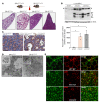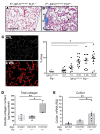Expression of mutant Sftpc in murine alveolar epithelia drives spontaneous lung fibrosis
- PMID: 29920187
- PMCID: PMC6118576
- DOI: 10.1172/JCI99287
Expression of mutant Sftpc in murine alveolar epithelia drives spontaneous lung fibrosis
Abstract
Epithelial cell dysfunction is postulated as an important component in the pathogenesis of idiopathic pulmonary fibrosis (IPF). Mutations in the surfactant protein C (SP-C) gene (SFTPC), an alveolar type II (AT2) cell-restricted protein, have been found in sporadic and familial IPF. To causally link these events, we developed a knockin mouse model capable of regulated expression of an IPF-associated isoleucine-to-threonine substitution at codon 73 (I73T) in Sftpc (SP-CI73T). Tamoxifen-treated SP-CI73T cohorts developed rapid increases in SftpcI73T mRNA and misprocessed proSP-CI73T protein accompanied by increased early mortality (days 7-14). This acute phase was marked by diffuse parenchymal lung injury, tissue infiltration by monocytes, polycellular alveolitis, and elevations in bronchoalveolar lavage and AT2 mRNA content of select inflammatory cytokines. Resolution of alveolitis (2-4 weeks), commensurate with a rise in TGF-β1, was followed by aberrant remodeling marked by collagen deposition, AT2 cell hyperplasia, α-smooth muscle actin-positive (α-SMA-positive) cells, and restrictive lung physiology. The translational relevance of the model was supported by detection of multiple IPF biomarkers previously reported in human cohorts. These data provide proof of principle that mutant SP-C expression in vivo causes spontaneous lung fibrosis, strengthening the role of AT2 cell dysfunction as a key upstream driver of IPF pathogenesis.
Keywords: Fibrosis; Pulmonary surfactants; Pulmonology.
Conflict of interest statement
Figures










Comment in
-
Lung injury and fibrosis induced by a mutant form of surfactant protein C.J Clin Invest. 2018 Aug 31;128(9):3745-3746. doi: 10.1172/JCI122727. Epub 2018 Aug 13. J Clin Invest. 2018. PMID: 30102252 Free PMC article.
-
Revealing the Secrets of Idiopathic Pulmonary Fibrosis.N Engl J Med. 2019 Jan 3;380(1):94-96. doi: 10.1056/NEJMcibr1811639. N Engl J Med. 2019. PMID: 30601735 Free PMC article. No abstract available.
Similar articles
-
An SFTPC BRICHOS mutant links epithelial ER stress and spontaneous lung fibrosis.JCI Insight. 2019 Mar 21;4(6):e126125. doi: 10.1172/jci.insight.126125. eCollection 2019 Mar 21. JCI Insight. 2019. PMID: 30721158 Free PMC article.
-
Epithelial Expression of an Interstitial Lung Disease-Associated Mutation in Surfactant Protein-C Modulates Recruitment and Activation of Key Myeloid Cell Populations in Mice.J Immunol. 2019 May 1;202(9):2760-2771. doi: 10.4049/jimmunol.1900039. Epub 2019 Mar 25. J Immunol. 2019. PMID: 30910861 Free PMC article.
-
Role of CCR2+ Myeloid Cells in Inflammation Responses Driven by Expression of a Surfactant Protein-C Mutant in the Alveolar Epithelium.Front Immunol. 2021 Apr 22;12:665818. doi: 10.3389/fimmu.2021.665818. eCollection 2021. Front Immunol. 2021. PMID: 33968067 Free PMC article.
-
Lost after translation: insights from pulmonary surfactant for understanding the role of alveolar epithelial dysfunction and cellular quality control in fibrotic lung disease.Am J Physiol Lung Cell Mol Physiol. 2015 Sep 15;309(6):L507-25. doi: 10.1152/ajplung.00139.2015. Epub 2015 Jul 17. Am J Physiol Lung Cell Mol Physiol. 2015. PMID: 26186947 Free PMC article. Review.
-
Emerging evidence for endoplasmic reticulum stress in the pathogenesis of idiopathic pulmonary fibrosis.Am J Physiol Lung Cell Mol Physiol. 2012 Apr 15;302(8):L721-9. doi: 10.1152/ajplung.00410.2011. Epub 2012 Jan 27. Am J Physiol Lung Cell Mol Physiol. 2012. PMID: 22287606 Free PMC article. Review.
Cited by
-
Human-Based Advanced in vitro Approaches to Investigate Lung Fibrosis and Pulmonary Effects of COVID-19.Front Med (Lausanne). 2021 May 7;8:644678. doi: 10.3389/fmed.2021.644678. eCollection 2021. Front Med (Lausanne). 2021. PMID: 34026781 Free PMC article. Review.
-
Functional Genomics of ABCA3 Variants.Am J Respir Cell Mol Biol. 2020 Oct;63(4):436-443. doi: 10.1165/rcmb.2020-0034MA. Am J Respir Cell Mol Biol. 2020. PMID: 32692933 Free PMC article.
-
Innovations in Childhood Interstitial and Diffuse Lung Disease.Clin Chest Med. 2024 Sep;45(3):695-715. doi: 10.1016/j.ccm.2024.04.002. Clin Chest Med. 2024. PMID: 39069332 Free PMC article. Review.
-
A census of the lung: CellCards from LungMAP.Dev Cell. 2022 Jan 10;57(1):112-145.e2. doi: 10.1016/j.devcel.2021.11.007. Epub 2021 Dec 21. Dev Cell. 2022. PMID: 34936882 Free PMC article.
-
Alveolar lipids in pulmonary disease. A review.Lipids Health Dis. 2020 Jun 3;19(1):122. doi: 10.1186/s12944-020-01278-8. Lipids Health Dis. 2020. PMID: 32493486 Free PMC article. Review.
References
-
- Travis WD, et al. An official American Thoracic Society/European Respiratory Society statement: Update of the international multidisciplinary classification of the idiopathic interstitial pneumonias. Am J Respir Crit Care Med. 2013;188(6):733–748. doi: 10.1164/rccm.201308-1483ST. - DOI - PMC - PubMed
-
- Mulugeta S, Nureki S, Beers MF. Lost after translation: insights from pulmonary surfactant for understanding the role of alveolar epithelial dysfunction and cellular quality control in fibrotic lung disease. Am J Physiol Lung Cell Mol Physiol. 2015;309(6):L507–L525. doi: 10.1152/ajplung.00139.2015. - DOI - PMC - PubMed
Publication types
MeSH terms
Substances
Grants and funding
LinkOut - more resources
Full Text Sources
Other Literature Sources
Molecular Biology Databases

